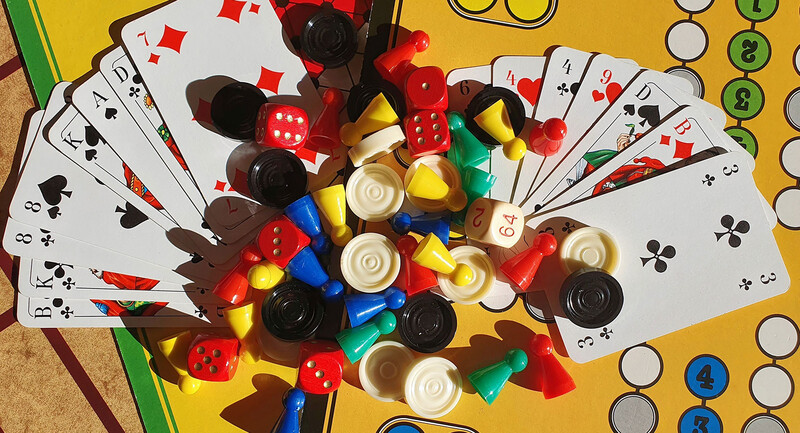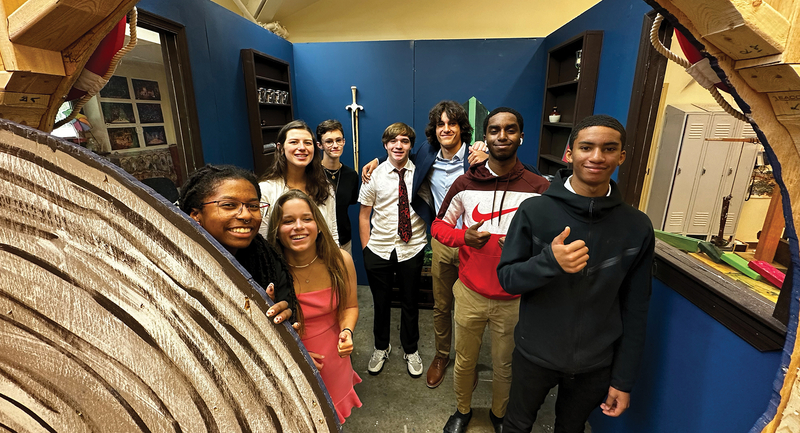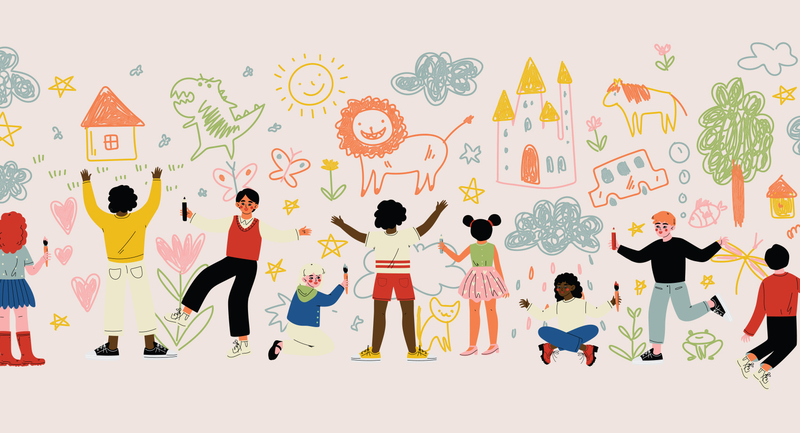I have a hard time losing weight. I burn through all the strategies—counting calories, eating a ketogenic diet, intermittent fasting—but always get temporary results. Recently, though, I came across an app that does something different. It makes fitness a game. It’s called “Nerd Fitness,” and it presents the user as the hero of a fitness journey. When I look at my fitness app, I no longer see an overweight man struggling to make healthy choices with limited time and no emotional energy. I see a cape wearing, masked champion who only needs to drink one more glass of water to stop the evil “Hydrato” from poisoning my city’s water supply. I have a goal, and I’m having fun.
We need to approach our classrooms the same way. Teachers already know that students perform better when engaged, but many of us need guidance on how to facilitate that engagement. Games are a great place to start. According to research published in The International Journal of Mental Health and Addiction, nearly 90 percent of our students play video games, with nearly one in five playing daily (Wittek, 2016). Pandemic-induced burnout has grown among students and as educators, we can find the elements in games that keep kids captivated and adapt them to fit our curriculum and make students the heroes of their own stories.
As an avid gamer myself, I have some thoughts on how to accomplish this. I find the definition of game that researcher and developer Jane McGonigal puts forward in her breakthrough work, Reality Is Broken: Why Games Make Us Better and How They Can Change the World, a useful starting point: “When you strip away the genre differences and the technological complexities, all games share four defining traits: a goal, rules, a feedback system, and voluntary participation” (McGonigal, 2012). So, let’s apply McGonigal’s four traits of games to the classroom.
Trait 1: The Goal
We need to go a step further than simply writing an objective on the board to fully engage our students. Master storyteller Kendall Haven lists “motive” as one of the eight essential elements of story, and one completely distinct from the goal itself. Haven says that “motives give a character compelling reasons to struggle to reach a goal” (Haven, 2018). What “compelling reason” do my students have to understand an author’s purpose in writing a specific piece or to give meaningful peer feedback to a classmate?
Without motive, goals are nothing more than prescriptivism and dead words on a whiteboard. Let’s give our young scholars motivation for completing these tasks. If the lesson for the day focuses on a particularly tricky passage from an older text, ask students to engage in a mystery that they can only solve by identifying and decoding imagery from the reading, or an in-depth exploration of archaic vocabulary.
Trait 2: The Rules
Every game has rules that define what is and isn’t possible. In a piece for Philosophia, Bartosz Kaluzinski lays out two types of rules: constitutive and regulative. “Constitutive rules… are those that have a creative function – they make it possible to perform particular actions or to participate in a particular practice” (Kaluziński, 2018). An example of a constitutive rule would be the queen’s ability to move in any direction or any number of spaces on a chess board.
Regulative rules, on the other hand, regulate behavior within a system. Teachers and schools excel at coming up with regulative rules, but we need to think of some constitutive rules that help our students see what’s possible in our classrooms. I can cast “judgement” on my enemies when my paladin reaches three holy power in World of Warcraft. What is the classroom equivalent of this? Maybe a student who has already earned the persuasive writing badge has the option to forgo the next assignment on this topic and write a paper the teacher will help her submit to a competition. Maybe the young man who has earned 10 citizenship tokens this grading period can trade them in for the right to bring snacks to class. Maybe at the beginning of classes, we do two minutes of either free or group stretches to get blood flowing through our bodies. These are just some ideas, but constitutive rules, like those described above, need to be present in our classrooms just as much as regulative ones.
Without motive, goals are nothing more than prescriptivism and dead words on a whiteboard. Let’s give our young scholars motivation for completing these tasks.
Trait 3: The Feedback System
For readers not versed in gaming, completing tasks often results in a reward of “experience points (XP)”, and when you reach a predetermined amount of XP, you “level up.” There’s usually a visible bar somewhere on the screen to show you progress toward this goal. World of Warcraft developers do this particularly well. When your character reaches a new level, a gold light flashes and you hear a gong, followed by a big block of text on the screen that reads: “You’ve reached level 45!” A list of new abilities, titles, achievements, as well as any new content that you have earned access to also appears. With such a satisfying communication of performance and reward, it’s no wonder people come back to games again and again.
What if our students could have this same sense of accomplishment in the classroom? We know how our units are structured. We know how many tasks we want our students to complete to demonstrate mastery. So why shouldn’t our students have mastery trackers or “XP bars” to show how much they have to do to “level up?” And when they do level up, there must be new content, new achievements, and new privileges.
This school year, for example, I am granting my students titles when they level up, based on the game Animal Crossing: New Horizon. In this game, characters have a title with two parts, but can mix and match these parts with any others you’ve collected to make something unique and funny. Sometimes these titles are unit-specific, for example, “Shakespearean Insults,” such as “fawning, fly-bitten flax wench,” or “cream-faced loon.” High school students love these. A wide range of tasks, from journaling, to mastering a standard in class, to pro-social behavior can earn these incentives and I have found that they often engage even previously reluctant students.
Or, students could gain access to “boss battles” as they progress. These could simply be tests, or more ornate exams with illustrations of monsters—perhaps each correct answer weakens the boss—or they could be online games. Either way, this represents the summative assessment and the final step before the next level and completion of a mastery badge. This is a great chance for teachers to either be creative, coming up with their own stories about the challenge we’re overcoming with the exam, or to use pre-existing software to turn assessments into something more. Platforms such as Playbrighter and Classcraft have enabled teachers to turn their tests into fantasy games for years.
The “boss battle,” however, prompts the question of failures. Students will miss the mark on some units. What would a gamified response to a student failing a quiz look like? Well… when I mess up and fail to complete a challenge in a game, am I marked as a failure and left behind? Absolutely not. I’m teleported to the nearest graveyard, probably needing to repair my armor—perhaps we have the student reflect on the questions they missed to rebuild their “hit points” before another attempt, reread the “boss mechanics in the dungeon guide” to remediate the missed content, and ultimately, try again (retesting).
Trait 4: Voluntary Participation
We may run into participation roadblocks. As McGonigal writes, “games make us happy because they are hard work that we choose for ourselves, and it turns out that almost nothing makes us happier than good, hard work” (2012). An unwilling participant may become resentful of both the material and the teacher. This is where variety comes into play, both in terms of activities and methods of accomplishing them. We need to explore what motivates a student to participate.
According to neuroscientist and game designer Amy Jo Kim, not everyone will be interested in badges and levels, and that extrinsic motivation isn’t a one-size-fits-all solution. Kim finds that people participate in games for four primary reasons: to compete, to express, to collaborate, and to explore (Kim, 2018). We must make sure that all of these “player types” find a home in our classrooms.
The Competitors
Who they are: Competitors like to measure themselves against their classmates. “Competitors are motivated by testing their skills. . . They find external rankings and zero-sum mechanics appealing. . . [They] love to develop their skills and showcase their prowess.” (Kim, 2018).
How we hook them: These students are especially motivated by tangible feedback, such as badges that display students’ achievements, or they could strive to obtain titles that are more difficult to get to. Author and teacher Michele Haiken gives her reading groups the chance to earn badges that are specific to the content they’ve mastered: “When my students are working in book clubs, they are working on earning badges to show their reading and understanding of the text. Students work toward completing different badges to show mastery of a concept, standard or skill” (Haiken, 2020). I hesitate to put a ranking in the classroom because not everyone wants their progress broadcast, but rewards for the first few to reach mastery could work.
The Expressers
Who they are: Expressers want just what the name implies: opportunities for self-expression. They are looking for ways to personalize the classroom experience and display their uniqueness. “They’ll use any available tools to make things others admire and emulate” (2018).
How we hook them: Badges, self-created titles, and other ways for students to creatively show off their individual personalities can be quite effective. In addition, writing time in the ELA classroom needs to be geared toward personal expression, for example: journaling with nudges rather than predetermined prompts. We should give this group the chance to share often and present their work creatively.
The Collaborators
Who they are: In gaming parlance, these are our dungeon delvers, raiders, and those who participate in multiplayer content. They like to take on specific roles and collaborate to achieve things with a group. Kim says, “They love to ‘win together’ and measure success as a collective impact.”
How we hook them: Group work, plain and simple. Unlike the competitors, they will not worry about having the highest score on an assignment or the best performance in a game, because they want to feel like they contribute meaningfully to the success of their classmates. Make space for supporting roles and spend plenty of time in intentional groupings.
The Explorers
Who they are: Explorers most often value individual discovery, though they “enjoy relationship-building via knowledge exchange” (Kim, 2018). An explorer will want to accumulate knowledge on their own, but still finds pleasure in sharing their learning and experiencing the learning of others, such as in a research project with presentations at the end.
How we hook them: Like our collaborators, explorers want to work with others now and then. These are the students most likely to enjoy a quest where they must solve a problem on their own and share their findings with a group. An assignment that allows explorers to teach a classmate new information or skills is ideal.
Putting It All Together
What does a day in the truly gamified classroom look like? Here’s one way I could structure an ELA lesson in my classroom:
First thing in the morning, students come in and begin writing in their adventure logs. I like to begin classes by journaling to ease students in and prime them thematically for the lesson. It also provides fertile soil to dig in for future narratives. For those intimidated by the blank page, I provide a nudging prompt. As students write, I walk around and place a small sticker on the inside cover of student logs when I see them participating. They can trade these in once they reach 20 for a journaling badge to place on their logs. My journaling badges are vividly colored and say “Level # Diarist.” A few students share their writing (hello, competitors and expressers!) and receive an extra sticker for their efforts.
Students retrieve their “Author’s Purpose XP Bars” or progress trackers and explain what the class has covered in a particular unit to gain the knowledge they have so far. My XP bars are on paper and we fill them in as we progress through our standards, but these could easily be managed digitally.
Time to dig into some reading! Classes work with their small reading groups on guiding questions to uncover character motivations, with each group assigned a different character. They create a representative illustration of their character’s motivation and nominate a group hero to share their findings with the class, who will add the info about other group’s characters to their logs.
Wait a second! Based on one of the group’s findings, we begin to suspect that, say, author Arthur Miller left behind a coded message about life in modern America in his play The Crucible, but it’s going to take every bit of skill we’ve gained so far to decode it! I give each group a copy of the “coded” part of the play and urges them to make ciphers to help the class find its meaning. We have three options:
Examine stage directions.
Examine figurative language.
Examine the dialogue between characters.
Each group reports out their findings. At the end of class, students turn in their “ciphers,” and each student submits a sentence or two summarizing their group’s findings. I evaluate these statements and either have students fill in the next segment of their author’s purpose XP bars—granting access to the boss battle!—or have students who missed the mark take another shot at it during a tutorial session.
When we incorporate game design principles, such as identifying our player types and motivations, putting systems in place to both intrinsically and extrinsically reward our players, and making their goals clear, the classroom can become a much more exciting place for all of us.








